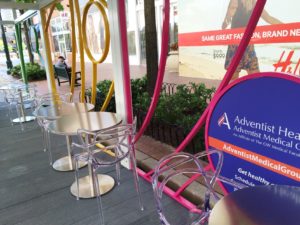Pop-Up Outdoor Offices? And, the Flint Water Crisis Revisited Some–Parts/Billion
 The piece in The Washington Post the other day opened: “Office-space design is undergoing a period of experimentation.” With the accompanying picture, I thought the lead was a bit understated.
The piece in The Washington Post the other day opened: “Office-space design is undergoing a period of experimentation.” With the accompanying picture, I thought the lead was a bit understated.
I first saw notice of the new concept at “Biznow, Washington DC Real Estate News” which titled its blurb: “Montgomery College Students Designed Peterson’s Latest Development.” That lead seems routed in hyperbole; rather the way Biznow tries to draw one’s attention. So, did the college students design some new office or retail building for mega-developer Peterson Cos.? Nope.
I’ve blogged in the past about smart technology for offices–inside. Offices outside? This is a first!
“OUTBOX” is what the applied-technology students at Montgomery College call their design.
What the pix doesn’t show is people sitting in chairs at the desks or tables, perhaps with i-Pads or plugged-in smart phones. Wi-Fi is there, yes, and note the roofing overhead to reduce glare on electronic screens.
You can find OUTBOX along Ellsworth Drive in downtown Silver Spring, MD. Its hours of operation are 10 to 7, but only through October.
 No Starbuck’s there. No latte or croissant. Those happen indoors. But, OUTBOX offers a new venue for people-watching also–except in swamp-like humidity in August where a few of the 20 seats might be unoccupied.
No Starbuck’s there. No latte or croissant. Those happen indoors. But, OUTBOX offers a new venue for people-watching also–except in swamp-like humidity in August where a few of the 20 seats might be unoccupied.
Nevertheless, an appealing idea. Will it become permanent? Look no farther than Long Beach, CA.
The developer who sponsored the temporary installation in downtown Silver Spring says, “We see it as a place where collaboration and creativity can foster in an enclosed yet outdoor environment.”
The piece’s writer, Jonathan O’Connell, concludes: “If inflexible buildings are holding us all back, then maybe outdoor office space is the answer. Unless it’s raining.”
♥
Back in February I blogged about the Flint, MI, water crisis. Now, from the current issue of “Columbia Magazine” comes an interview with Professor David Rosner, an expert on occupational disease, industrial pollution and lead poisoning. Turns out Rosner was asked to peer-review Dr. Mona Hanna-Attisha’s paper on the poisoning stemming from use of Flint River water to save the city some money. Rosner says: “This doctor, I could see, had documented a major public-health failure.”
In my earlier post I said that lead is well absorbed by humans. To the question, “Why is lead so dangerous?” Rosner says: “It’s a neurotoxin. It can harm people of all ages, and when ingested by children, it can lower IQ, make for behavioral problems, and create permanent neurological damage. The damage is mostly irreversible.”
Moreover: “Among public-health experts, there are consensus guidelines suggesting that fifteen parts of lead per billion parts of water is the upper level for ‘acceptable’ drinking water. In Flint, levels were sometimes at eleven thousand parts per billion of water. I recently saw a report about one Flint home where the contamination was at fifteen thousand.” OMG.
“This disaster was entirely preventable….Why would anyone allow children to drink from that river?”
What an unbelievable example of human marginalization!